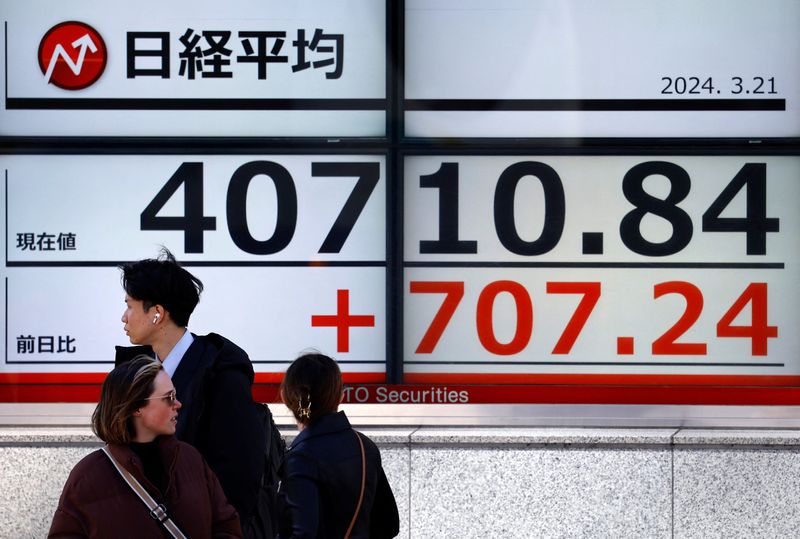
©Reuters. Passers-by walk past an electric screen showing Japan’s Nikkei stock average outside a broker in Tokyo, Japan, March 21, 2024. REUTERS/Issei Kato
By Rae Wee
SINGAPORE (Reuters) – Asian shares were close to a weekly gain on Friday and the Nikkei hit a record high, riding a rally in its global peers after the Swiss National Bank’s surprise rate cut sent investors into bets about who might be next.
The SNB’s 25 basis point rate cut on Thursday proved to be a boost of confidence for global risk appetite as markets rushed to bet on major central banks cutting funding costs this year , sending Wall Street to close at historic highs.
MSCI’s broadest index of Asia-Pacific shares outside Japan saw some profit-taking in early trading on Friday, after jumping nearly 2% in the previous session, and was down 0.17 %. However, the index was on track to gain more than 1% for the week.
Other benchmarks in Asia also reached new highs, with Taiwan’s weighted index hitting record highs. Both were on track for weekly gains of nearly 6% and 3%, respectively.
South Korea also hit a two-year high.
“It doesn’t hurt if central banks are adopting easing, that’s for sure,” said Rob Carnell, ING’s regional head of research for Asia-Pacific. “I expect this will provide further support if people start to look at greater prospects for easing.”
Traders were quick to increase bets on a June cut by the European Central Bank (ECB) and the Bank of England (BoE) following the SNB’s move.
BoE Governor Andrew Bailey said after the central bank’s rate decision on Thursday that the British economy was moving towards the point where rates can start to ease, while two of his colleagues also abandoned their calls of further increases.
The pound fell to a three-week low on the back of the BoE decision, and rose 0.11% to $1.26735. A weekly loss of more than 0.4% was expected.
The Swiss franc fell slightly to 0.8980 per dollar, after falling more than 1% in the previous session to a four-month low.
It was stuck near about an eight-month low on the euro.
“The SNB’s decision to cut rates this month will likely increase the likelihood that the (franc) can be used as a funding currency, particularly if the SNB signals that it is willing to match the ECB’s rate cuts this year,” said Jane Foley, senior FX strategist at Rabobank. “For now, the (franc) will likely remain weak.”
Elsewhere, stocks in China and Hong Kong were a sea of red, with the blue-chip CSI300 index down more than 0.5% and nearly 2% weaker, thanks to the yuan slipping past the level of 7.2 per dollar for the first time since November. .
DOLLAR RESILIENCE
While the Federal Reserve’s decision this week to stick to its projection of three rate cuts this year proved more accommodative than some expected and sent the dollar tumbling, it quickly recouped its losses.
The dollar pushed the yen closer to a multi-decade low on Friday and was last at 151.82, leading Japanese government officials to step up their bust efforts.
The greenback’s rebound came on the heels of another round of resilient U.S. economic data and as the Bank of Japan’s rate hike this week failed to move the needle on steep interest rate differentials between the two countries.
Likewise, the euro fell 0.08% to $1.0850, after trading in a tight range for much of the year.
“The market has been completely obsessed with this idea of a dollar turnaround for more than a year,” said ING’s Carnell. “It seems highly questionable when you consider how strong the American economy is.
“There just doesn’t seem to be an automatic sense that when the Fed cuts rates, there must be some dollar easing if the ECB, and other G10 central banks in particular, are doing the same or perhaps even more.”
As for commodities, the price fell 43 cents to $85.35 a barrel, while it fell 41 cents to $80.66 a barrel. [O/R]
fell 0.28% to $2,174.89 an ounce, after hitting an all-time high on Thursday. [GOL/]